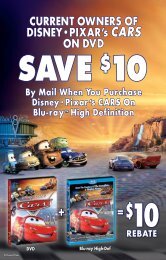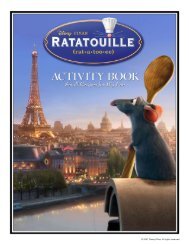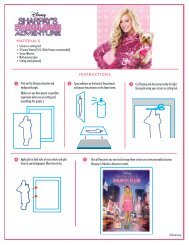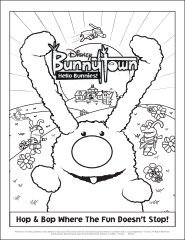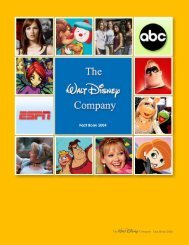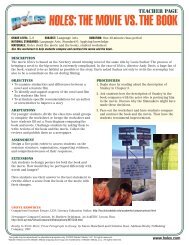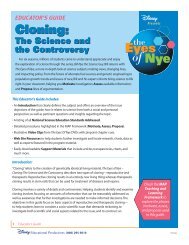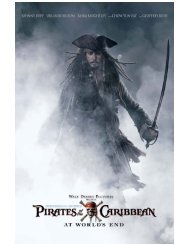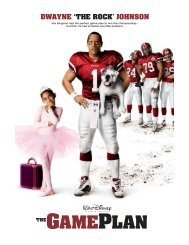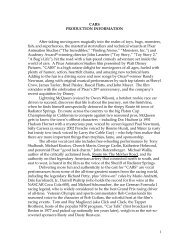introduction - Disney
introduction - Disney
introduction - Disney
You also want an ePaper? Increase the reach of your titles
YUMPU automatically turns print PDFs into web optimized ePapers that Google loves.
Teacher’s Study<br />
Guide
I N T R O D U C T I O N<br />
I N T R O D U C T I O N<br />
“Nothing great was ever achieved without enthusiasm.”<br />
Ralph Waldo Emerson, “Circles”<br />
America’s Heart & Soul is a film that celebrates the values that Americans<br />
hold dear. In an age where more and more pundits find themselves unable<br />
to speak of the greatness of America without using ironic quotation marks,<br />
producer and director Louis Schwartzberg has created a film that will<br />
rekindle a viewer’s patriotism and love for the country.<br />
Rather than push some political agenda, however, Schwartzberg stresses the<br />
essential goodness in Americans and the ways in which their country has<br />
allowed them the freedom to follow their dreams—and while some of these<br />
dreams may seem like they were born in storybooks, others are more downto-earth.<br />
What a person’s passion is is not as important as the enthusiasm<br />
one has for the passion itself—this is why the segment about a Kentucky rug<br />
weaver is as inspiring as the one about a Chicago-born Olympic boxer.<br />
Some middle and high-school students may feel disconnected from the story<br />
of America; they read and learn about such events as the Revolutionary<br />
War, the Civil War or even the 1950s and feel that the people living then<br />
were not as sophisticated or savvy as they are today. However, America’s Heart<br />
& Soul suggests that the fundamental values and desires of Americans have<br />
not drastically changed since the first rumblings of the Revolution were felt<br />
on the streets of Boston.<br />
This study guide is designed to aid you, the classroom teacher, in sparking<br />
discussions about the film’s structure, techniques and themes. Schwartzberg’s<br />
combination of gorgeous photography and seamlessly edited portraits of<br />
authentic Americans revealing their hopes, frustrations and triumphs is<br />
guaranteed to generate dynamic conversations about the country and the<br />
people who make it so great.<br />
“Give me a condor’s quill!<br />
Give me Vesuvius’ crater for<br />
an inkstand!”<br />
Herman Melville, Moby Dick<br />
2<br />
2
T W E N T Y Q U E S T I O N S<br />
Some Quick Discussion Starters<br />
C H A R A C T E R C O N N E C T I O N S<br />
These questions are designed to help you and your students “dive in” to the<br />
themes of America’s Heart & Soul. They may be altered and turned into<br />
journal assignments or completed in smaller groups. The topics of some of<br />
these Discussion Starters are explored more fully in other parts of this Study<br />
Guide.<br />
1 Who was your favorite character? Why did this character’s story affect you?<br />
2 What character struck you as the most eccentric? Did he or she seem less eccentric as the film progressed?<br />
3 To what degree do director Louis Schwartzberg’s cinematography and editing affect the viewer?<br />
4 If you had to describe the film to one who had never seen it, what would you say? What does your<br />
description reveal about the way you interpreted the film?<br />
5 How does the film reflect Emerson’s idea that “Nothing great was ever achieved without enthusiasm?”<br />
6 Which activity depicted in the film looks like it would be fun to try? Why?<br />
7 What can you infer from the film about Louis Schwartzberg’s feelings about America?<br />
8 How does the film treat different kinds of power: physical, mental, spiritual and artistic?<br />
9 How is the film essentially structured like a traditional narrative or three-act play?<br />
10 What does the film suggest about human limitations? How can they be faced and conquered?<br />
11 Is your region of the country featured in the film? If so, what does Louis Schwartzberg stress about it<br />
through his cinematography?<br />
12 Name some characters who make things; how does the film explore the importance<br />
of creativity?<br />
13 What is your favorite image from the film? How does this image reflect the film’s themes and ideas?<br />
14 What characters do you think displayed the greatest amount of self-discipline? What does the film<br />
suggest about the paradoxical relationship between discipline and freedom?<br />
15 Which character in the film most reminds you of someone you know or admire?<br />
What qualities make these people admirable?<br />
16 How does the film explore the rejuvenating nature of music?<br />
17 How does the film explore the “big ideas” of America as found in the<br />
Declaration of Independence and the Constitution?<br />
18 What does the film suggest about the importance of our past and future?<br />
19 List any ten characters from the film and an adjective to describe each one. Then see if you can use<br />
these same adjectives to describe any other characters. What does any overlap suggest about how these<br />
people were chosen for the film?<br />
20 Why did director Louis Schwartzberg choose this title for his film?<br />
A younger or first-time viewer may first see the film and not grasp the<br />
many ways (both obvious and subtle) that the characters are connected.<br />
These activities are designed to get students thinking about these<br />
connections and, ultimately, the issues of Schwartzberg’s film.<br />
Match Game<br />
Have each student randomly choose two numbers between 1-25 and record these numbers<br />
in their notebooks. Next, distribute copies of the America’s Heart & Soul: Character List.<br />
Have students then see which characters correspond to their two chosen numbers and<br />
then brainstorm about how these characters are alike. You may then wish to have students<br />
share their pairs and ideas with the class, complete a short writing assignment in which the<br />
students offers a more detailed comparison or even create a short “play” in which these two<br />
characters speak to each other about their passions and values.<br />
Panel Discussion<br />
Distribute copies of the Character List and assign students the roles of different characters.<br />
(Each student will assume the role of one character.) Then have a small number of students<br />
(5 or 6) sit in front of the class and complete a “panel discussion” with both the teacher<br />
and students playing “host.” Panelists should respond in character to questions from the<br />
“hosts”; questions such as, “What do you find to be so thrilling about your life?” “How<br />
has where you live affected you?” may provoke interesting responses. After one “panel” has<br />
spoken for a while you can create new panels with different characters.<br />
“I’ve been broke many times, but<br />
I’ve never<br />
Quotation Grab-Bag<br />
Cut the 15 different quotations on the America’s Heart & Soul: Quotations sheet into<br />
separate strips, fold them and put them into a bag. (All of the quotations are taken from<br />
the film or accompanying book.) Then have students (alone or working in smaller teams)<br />
select a quotation at random and brainstorm some ways in which the characters from<br />
the film reflect or embody the quotation’s idea. (You may want to distribute copies of<br />
the America’s Heart & Soul: Character List to jog students’ memories.) Finally, have<br />
each student or team present their ideas to the class or in the form of a short writing<br />
assignment.<br />
Arresting Images<br />
The book of photographs that accompanies America’s Heart & Soul<br />
is filled with striking images both from the film and the director’s<br />
travels across the country. Have students select a favorite photograph<br />
(or assign them one of your choosing) and begin a discussion<br />
about the ways in which the photograph “speaks” to them: What is<br />
emphasized about the photograph’s subject? What is the photograph’s<br />
theme? (You may even wish to do this before you show the film.) Then<br />
have students either compose short prose or poetic pieces based on<br />
the photographs—or have students use their own cameras to create, as<br />
a class, their own book in which they reveal the “heart and soul” of<br />
their schools or communities.<br />
3 4
C H A R A C T E R C O N N E C T I O N S<br />
A M E R I C A ’ S H E A R T & S O U L : Q U O T A T I O N S<br />
A Day in the Life<br />
Ask students to select a character that they find particularly interesting or inspiring.<br />
Then have students compose fictional entries from their chosen character’s journals.<br />
The purpose is to have students imagine what a “day in the life” of these characters<br />
would be like. What are some of the character’s frustrations? Inspirations? Triumphs?<br />
Ultimately, you may wish to discuss the ways in which imagining a character’s daily<br />
life and thoughts allows the viewer to better understand what makes the character so<br />
inspiring.<br />
Big Ideas and “Regular Folks”<br />
While describing his occupation, oil well firefighter Ace Barnes remarks, “We’re just<br />
common folks. We’re firefighters.” One of director Louis Schwartrzberg’s aims in<br />
making America’s Heart & Soul was to celebrate the ways in which “common folks”<br />
do uncommon things. To generate a discussion of how the film explores this idea,<br />
put the following words on the chalkboard (with plenty of room between them):<br />
BRAVERY, PASSION, HEART, SOUL, FREEDOM, MOBILITY and LOVE. Ask<br />
students to then, as a class, silently approach the board and write the names of<br />
characters in the film who they feel embody one of these abstract ideas. After all students<br />
have had a chance to write some names, examine the results: are any names repeated in<br />
different categories? Are there any characters whose stories seem to defy what some feel<br />
“common folks” can accomplish? Ultimately, you may wish to discuss how these “big ideas”<br />
are intertwined.<br />
“The World Don’t Bother Me None”<br />
The original song written and performed by John Mellencamp for America’s Heart & Soul<br />
reflects the energy and attitude of the film itself. Ask students to consider the song’s title<br />
and refrain as suggestive of the film’s characters and how many of them have overcome the<br />
adversity they found in “the world”: How do people such as Ace Barnes, Michael Bennet,<br />
Erik Weihenmayer and Rick and Dick Hoyt<br />
prove that incredible things may be achieved<br />
if people refuse to let “the world” bother or<br />
discourage them?<br />
“Cherish your freedom.” Roudy Roudebush, Horse Wrangler<br />
“It’s not just one kind of food or one kind of music or one kind of landscape. It’s the<br />
wonderful diversity of this country that makes this place so great.”<br />
Mark Savoy, Accordion Maker<br />
“There’s nothing more important than watching your children grow up.<br />
Learn new things every day.” George Woodard, Jr., Dairy Farmer<br />
“I guess making hats is just my way of speaking to the world.”<br />
Alexander Conley III, Hatmaker<br />
“I don’t know what the answer is . . . but I know it’s not quitting.”<br />
James Andreozzi, Steel Worker<br />
“Laughing. It works universally for everybody and it’s the best therapy<br />
in the world. If you’re laughing, you’re probably happy.”<br />
Paul Stone, Explosive Artist<br />
“I wish I had a dime for every smile I get. I’d be wealthy.”<br />
Larry Fuentes, Car Artist<br />
“To me it isn’t junk. It’s rusty gold.” Dan Klennart, Junk Artist<br />
“Once something is gone, it becomes extinct and unless you recreate pr<br />
preserve it they get lost forever. So it’s important to keep the past alive.”<br />
Kenwood Cassens, Pilot<br />
“I want to see your eyes opening up with not the shades or shadows covering them,<br />
but love beaming with light from your eyes, which tells me it’s coming from your<br />
soul. I want that. Heart and soul.”<br />
Reverend Cecil Williams, Glide Memorial Church<br />
“For me, all the great things that have ever come to me have come from reaching out,<br />
and I think life is just a process of reaching out into the darkness.”<br />
Erik Weihenmayer, Blind Climber<br />
“To live free or die is not just an empty slogan on a license plate.”<br />
John Harrigan, Newspaper Editor<br />
“It really gives you a rush.” Patty Wagstaff, Aerobatic Pilot<br />
“I’ve been broke many times, but I’ve never been poor.”<br />
Minnie Yancy, Rug Weaver<br />
“I love growing grapes . . . and I don’t think it’s the kind of thing you can learn to<br />
do in 25 or 30 years. I think it takes a lifetime.”<br />
Ed Holt, Grape Grower<br />
5 6
T H E M A T I C C O N N E C T I O N S<br />
A first-time, younger viewer may not immediately grasp the themes of the<br />
film or some of the more subtle ways in which its characters are connected.<br />
These activities are designed to promote examinations of the film’s specific<br />
themes.<br />
Mobility is Freedom<br />
Begin by asking students to identify all the characters who literally “move”—you will most<br />
likely receive replies that include the following names:<br />
John “Yac” Yacobellis<br />
(bike messenger)<br />
Patty Wagstaff (aerobatic pilot)<br />
Amelia Rudolph (cliff dancer)<br />
The Vasquez Family (salsa dancers)<br />
Erik Weihenmayer (blind climber)<br />
Rick and Dick Hoyt (Boston Marathon runners)<br />
The Power In-Between<br />
At one point during her segment, cliff dancer Amelia Rudolph remarks, “There is a lot of<br />
power in things that are between things.” This remark applies perfectly to the power of the<br />
Bandaloop Cliff Dancers, since they are “in-between” climbers and dancers. The initiallyseeming<br />
odd combination of passions is what gives cliff dancing its power and beauty.<br />
Ask students to consider the ways in which America’s Heart & Soul explores “the<br />
power” of “in-between things.” Which characters combine two types of materials or<br />
passions to produce a powerful new endeavor? The actions of characters such as Paul Stone<br />
(Explosive Artist) and Dan Klennart (Junk Artist) may be good starting points for a discussion<br />
before moving into ones about other characters who<br />
have found an “in-between” among more abstract things,<br />
such as religion and music (Mosie Brooks), prison and<br />
the Olympics (Michael Bennet) or business and pleasure<br />
(Ben Cohen).<br />
7<br />
Discuss the ways in which these characters’ mobility reflects their<br />
personalities as well as their values: What does a viewer come to understand<br />
about why Amelia Rudolph loves cliff dancing or why Patty<br />
Wagstaff loves completing such challenging stunts? You may want to<br />
refer to some or all of the following quotations from the film:<br />
“I always felt like a leaf floating in the wind; even though it’s the most freedom you<br />
could ever have, it’s also the most structured, because in aerobatic flying, one mistake<br />
could be your last.”<br />
Patty Wagstaff (Aerobatic Pilot)<br />
“Mobility is freedom.”<br />
Rick Hoyt (Boston Marathon runner and father of Dick Hoyt)<br />
“Once I’m anchored in and understand the system, I’m free.”<br />
Amelia Rudolph (Cliff Dancer)<br />
After a discussion of the thrills of literal mobility, consider one about<br />
figurative mobility: Which characters have figuratively “moved” in order<br />
to pursue their passions? The following is a partial list of characters whose<br />
stories explore the importance of figurative mobility:<br />
Roudy Roudebush (moved from alcoholism to sobriety)<br />
Mosie Burks (moved from daughter to mother of six)<br />
Ben Cohen (moved from frequently-fired odd-jobber<br />
to CEO of Ben & Jerry’s)<br />
Welton Steelworkers (moved from employees to owners)<br />
Michael Bennet (moved from convict to Captain of<br />
U.S. Olympic Boxing Team)<br />
Ask students to consider the effects of these “moves” on the characters: how<br />
did changes in the directions of their lives lead togreater freedom<br />
and self-fulfillment? Finally, ask students to compose (and perhaps share) some<br />
of their own “Stories of Movement” in which they detail some of the literal and<br />
figurative movements they have experienced.<br />
Finding One’s Passion<br />
In the book America’s Heart & Soul, director Louis<br />
Schwartzberg remarks: When people watch America’s<br />
Heart & Soul or read this book, I hope they hear the<br />
call to “find their passion.” If you find your passion, I<br />
think you’ll be happy, it will rejuvenate your soul, and<br />
you can still make a living.<br />
After reviewing the above quotation with your students, ask<br />
them to identify the segments of the film that they found to be<br />
especially poignant, inspiring—or just plain fun. Then ask your<br />
students to consider the ways in which the film encourages the<br />
viewer to become as excited about the characters’ passions as the<br />
passions themselves: How, for example, does the film’s cinematography,<br />
editing and soundtrack convey Patty Wagstaff’s rush<br />
of adrenaline when she performs her stunts? Then have students<br />
select other segments of the film and explain—in as much de-<br />
tail as possible—how the elements of successful filmmaking<br />
combine to convey the theme of the individual segment,<br />
whether it be the quiet introspection of Minnie Yancy as she<br />
weaves or the energy of the members of the Vasquez Family<br />
as they dance. Students may wish to review clips from the<br />
film or you may wish to show some in class while supplying<br />
your own “DVD commentary.”<br />
Finally, ask students to identify one of their passions—or a<br />
passion they would love to pursue in the future. What is<br />
it about this passion that appeals to them? To what extent is the pursuit of this passion<br />
related to the freedoms we currently enjoy as Americans? Is there anything inhibiting their<br />
pursuit of their passions?<br />
8
L I T E R A T U R E - B A S E D A C T I V I T I E S<br />
Music and America<br />
Many of the characters in America’s Heart & Soul are musicians and the film offers an<br />
array of musical styles:<br />
The following activities ask students to re-examine a piece of writing,<br />
question its values or issues and then relate the text to the film. However,<br />
one does not have to be an English teacher to spark conversations about<br />
these texts and their relevance to America’s Heart & Soul.<br />
Characters<br />
Musical Genre<br />
The Climates of the Country<br />
In his 1782 work Letters from an American Farmer, Hector St. John De Crevecoeur asks,<br />
“What is an American?” Have your students meet in teams of 4 or 5 and brainstorm some<br />
possible answers to the question and then present their ideas to the class. After each team<br />
has presented, distribute copies of Handout 1: Crevecoeur’s Response and ask the class to<br />
compare and contrast his reply with theirs.<br />
You will notice that Crevecoer’s response reflects the tenor of his times (he only mentions<br />
emigration from Europe) but also, in his optimism, the spirit of our own—and that which is<br />
found throughout America’s Heart & Soul.<br />
After the class discussion, have students explain (again in groups or in writing) how<br />
America’s Heart & Soul responds to the same question: According to the film, what qualities do<br />
Americans share? What do they value? How does the film explore the importance and<br />
significance of the “different climates” that Americans currently “inhabit”—whether these<br />
climates are literal (as with Paul Stone or Minnie Yancy) or more figurative (as with Michael<br />
Bennet or Reverend Cecil Williams)? Ultimately, you may want to have your students compose<br />
their own “Letters from an American Teenager” in which they describe what they find to be<br />
the current American values and assumptions.<br />
Marc and Ann Savoy<br />
Mosie Burks<br />
George Woodard<br />
Frank and Dave Pino<br />
James and Troy Andrews<br />
Danielle de Niese<br />
David Krakauer<br />
The Vasquez Family<br />
Cajun<br />
Gospel<br />
Bluegrass<br />
Rock and Roll<br />
Jazz<br />
Opera<br />
Klezmer<br />
Salsa<br />
However, the film never “votes” on which style is the most relevant or meaningful: the point<br />
is, of course, that each style of music speaks in different ways to those who have made it<br />
their passion. Ask students to identify all of the types of music that can be heard in America<br />
today—and to also identify as many sub-genres of the types as they can. Then begin a<br />
discussion of why director Louis Schwartzberg would include so much music in a film about<br />
America and how their favorite kinds of music reflect their personalities and passions.<br />
. The Songs of Americans at Work<br />
Many segments of America’s Heart & Soul glorify work and the people who do it; some of<br />
these jobs are relatively common (such as a dairy farmer or bike messenger) while others are<br />
more removed from the mainstream (such as a horse wrangler or oil-well firefighter).<br />
In his 1855 collection Leaves of Grass, the poet Walt Whitman offered his readers his<br />
appreciation for the workers of America. Distribute copies of Handout 2: Whitman and Work<br />
and have the students read Whitman’s poem “I Hear America Singing.” (You may want to have<br />
them first read it to themselves and then in a “choral reading” as a group.)<br />
Next, begin a conversation about the poem: what kinds of jobs does Whitman glorify here?<br />
How is working like singing—why would Whitman choose to examine labor in this light? How<br />
is the joy of music analogous to the joy of doing a job one loves? How does Schwartzberg’s film<br />
“sing” of those who love what they do, many of whom are, literally, musicians? Finally, have<br />
students compose their own poems: they can write imitations of Whitman in which they use<br />
occupations from the film or the ones that are performed in their own towns, states or regions<br />
of the country.<br />
9 10
11<br />
The Land / People Connection<br />
One major theme of America’s Heart & Soul is the connection between<br />
the land and the people—how one influences the other. In his book that<br />
accompanies the film, director Louis Schwartzberg states, “The circular<br />
relationship between people and the land has always intrigued me. I think that<br />
people shape the land and the land shapes the people’s psyche.”<br />
While this idea is not exclusive to America, it does have a long tradition<br />
in this country that can be traced back to the Native Americans. Distribute<br />
copies of Handout 3: The Navajo Origin Legend. (This is the story of<br />
how the Navajo were created.) After students read and annotate the handout,<br />
begin a discussion of what a reader can infer about the values of the<br />
Navajo: how does the Navajo Origin Legend reveal a deep reverence for what<br />
comes from nature as well as the spiritual connection between nature and man?<br />
What does the text suggest about the relationship between natural phenomena<br />
and human life?<br />
Next begin a discussion of how America’s Heart & Soul explores a similar con-<br />
nection: What people in the film reveal a deep connection with the land? How<br />
does the film explore the ways in which the<br />
land has shaped these people’s personalities<br />
and attitudes? Students might discuss their<br />
own sense of connection to the land as found<br />
in their everyday lives or when they visit majestic<br />
places like the ones shown in the film.<br />
Here is a partial list of characters whose<br />
egments in the film reveal strong land /people<br />
connections:<br />
Roudy Roudebush<br />
(horse wrangler)<br />
Marc and Ann Savoy (Cajun musicians)<br />
Minnie Yancy (rug weaver)<br />
George Woodard (dairy farmer)<br />
Ed Holt (grape grower)<br />
Charles Jimmie, Sr. (Tinigit Elder)<br />
Erik Weihenmayer (blind climber)<br />
Of course, students can also discuss the<br />
ways in which characters such as bike<br />
messenger John “Yac” Yacobellis or the<br />
Reverend Cecil Williams reveal their<br />
connections to more urban landscapes.<br />
Ultimately, you may have students<br />
compose short pieces (in prose or verse)<br />
about their own connections to the land<br />
itself.<br />
Our life is frittered away detail.Simplicity, simplicity,<br />
by<br />
simplicity! I say, let your fairs be as two or three, and not a<br />
afhundred<br />
or a thousand;<br />
instead of a million count<br />
half a dozen, and keep your<br />
accounts on your thumb-nail.<br />
S i m p l i f y , s i m p l i f y .<br />
Instead of three meals<br />
a day, if it be necessary<br />
eat but one; instead of a<br />
hundred dishes, five; and<br />
reduce other things in<br />
proportion.<br />
. Simplify, Simplify<br />
In 1845, a twenty-eight-year-old former teacher—Henry David Thoreau—moved into a small cabin<br />
that he built with his own hands on the outskirts of Concord, Massachusetts. For two years he lived<br />
in relative isolation, growing his own food, exploring the natural world and writing in his journals.<br />
1854 saw the publication of his record of this period, Walden or Life in the Woods. Thoreau’s book<br />
is a record of his trials and triumphs while attempting to be wholly self-sufficient; Walden also<br />
explores the discoveries Thoreau made about human contentment and the ways in which materialism<br />
can corrupt the human sprit.<br />
Distribute copies of Handout 4: Simplify, Simplify and allow students some time to silently read<br />
and annotate the passage. Then begin a discussion of Thoreau’s opinions of American life. While<br />
he wrote these words over 150 years ago, many of them still ring true today. What kind of life does<br />
Thoreau advocate here? What does he really mean when he urges the reader to “keep your accounts<br />
on your thumb-nail” or to only eat one meal a day? Do you agree with his objections to the speed at<br />
which we live our lives? What are some adverse effects of “living too fast?” According to Thoreau,<br />
what would a more slowly-paced life allow us to achieve?<br />
To relate Walden to America’s Heart & Soul, ask students to first identify characters who seem to be<br />
living their lives according to Thoreau’s command, “Simplify, simplify.” Then ask students to<br />
discuss the ways in which these characters are living lives not “frittered away by detail” and what<br />
value and fulfillment they have found in “simplicity.” (Note that “simplicity” here has no negative<br />
connotations, as in the term “simple-minded.”) Ultimately, you may want to have students list the<br />
ways in which their own lives are “frittered away by detail” and then the ways in which a dose of<br />
“simplicity” may allow them to focus on what is truly important.<br />
12
H A N D O U T 1 H A N D O U T 2<br />
Crevecoeur’s Response<br />
Whitman and Work<br />
“Here individuals of all nations<br />
are melted into a new race of men,<br />
whose labors and posterity will one<br />
day cause great changes in<br />
the world. Americans are the<br />
western pilgrims, who are carrying<br />
along with them that great mass<br />
of arts, sciences, vigor, and industry<br />
which began long since in the east; they<br />
will finish the great circle.<br />
The Americans were once scattered<br />
all over Europe; here they are<br />
incorporated into one of the finest<br />
systems of population which has ever<br />
appeared, and which will hereafter<br />
become distinct by the power of the<br />
different climates they inhabit.”<br />
I HEAR America singing, the varied carols I hear;<br />
Those of mechanics—each one singing his, as it should be,<br />
blithe and strong;<br />
The carpenter singing his, as he measures his plank or beam,<br />
The mason singing his, as he makes ready for work,<br />
or leaves off work;<br />
The boatman singing what belongs to him in his boat—the<br />
deckhand singing on the steamboat deck;<br />
The shoemaker singing as he sits on his bench—the hatter<br />
singing as he stands;<br />
The wood-cutter’s song—the ploughboy’s, on his way in the<br />
morning, or at the noon intermission, or at sundown;<br />
The delicious singing of the mother—or of the young wife at<br />
work—or of the girl sewing or washing—Each singing what<br />
belongs to her, and to none else;<br />
The day what belongs to the day—At night, the party of young<br />
fellows, robust, friendly,<br />
Singing, with open mouths, their strong melodious songs.<br />
Walt Whitman,<br />
Leaves of Grass (1854)<br />
Hector St. John De Crevecoeur,<br />
Letters from an American Farmer (1782)<br />
13 14
H A N D O U T 3<br />
H A N D O U T 4<br />
The Navajo Origin Legend<br />
When the gods first appeared, Blue Body and Black Body each<br />
carried a sacred buckskin. White Body carried two ears of<br />
corn, one yellow and one white. The gods laid one buckskin<br />
on the ground with the head to the west, and on this they<br />
placed the two ears of corn with their tips to the east. Over<br />
the corn they spread the other buckskin with its head to the<br />
east. Under the white ear they put the feather of a white eagle;<br />
under the yellow ear the feather of a yellow eagle. Then they<br />
told the people to stand back and allow the wind to enter.<br />
Between the skins the white wind blew from the east and the<br />
yellow wind from the west. While the wind was blowing, eight<br />
gods called the Mirage People came and walked around the<br />
objects on the ground four times. As they walked, the eagle<br />
feathers, whose tips stuck out from the buckskins, were seen to<br />
move. When the Mirage People finished their walk, the upper<br />
buckskin was lifted. The ears of corn had disappeared; a man<br />
and a woman lay in their place.<br />
The white ear of corn had become the man, the yellow ear had<br />
become a woman: First Man and First Woman. It was the wind<br />
that gave them life, and it is the wind that comes out of our<br />
mouths now that gives us life. When this ceases to blow, we die.<br />
In the tips of our fingers we see the trail of the wind: it shows<br />
us where the wind blew when our ancestors were created.<br />
Simplify, Simplify<br />
Our life is frittered away by detail. Simplicity, simplicity,<br />
simplicity! I say, let your affairs be as two or three, and not a<br />
hundred or a thousand; instead of a million count half a<br />
dozen, and keep your accounts on your thumb-nail. Simplify,<br />
simplify. Instead of three meals a day, if it be necessary eat but one;<br />
instead of a hundred dishes, five; and reduce other things in<br />
proportion.<br />
The nation itself, with all its so-called internal improvements,<br />
which, by the way, are all external and superficial, is an<br />
unwieldy and overgrown establishment, cluttered with furniture<br />
and tripped up by its own traps, ruined by luxury and heedless<br />
expense, by want of calculation and a worthy aim, as the million<br />
households in the land; and the only cure for it as for them is in a<br />
rigid economy. It lives too fast. Why should we live with such hurry<br />
and waste of life? We are determined to be starved before we are<br />
hungry. Men say that a stitch in time saves nine, and so they take a<br />
thousand stitches to-day to save nine tomorrow.<br />
15 16
B I G G E R , L O N G - T E R M P R O J E C T S<br />
C H A R A C T E R L I S T<br />
These projects use America’s Heart & Soul as a starting point and require<br />
more time to complete.<br />
Capturing People’s Passions<br />
Part of what makes America’s Heart & Soul so moving is the ways in which it invites its viewers<br />
to share the characters’ passions. If you teach computer or visual arts or have any students who<br />
are familiar with digital cameras or computer programs like imovie or iphoto, have them create<br />
short films in which they celebrate a fellow student’s passion the way that Louis Schwartzberg<br />
does in America’s Heart & Soul. If enough students become involved, organize a mini “film<br />
festival” in which the films are screened.<br />
Where We Come From<br />
During his interview, Cajun musician Mark<br />
Savoy remarks that people should know where<br />
they come from and “the languages that their<br />
ancestors spoke.” He also mentions how his<br />
children are living in the house once inhabited by<br />
their ancestors. Many characters in America’s Heart<br />
& Soul speak of the importance of tradition: figures<br />
like Charles Jimmie, Sr. and David Krakauer<br />
also stress the importance of their ancestors.<br />
Ask students to use the web and their relatives to research<br />
their own roots and prepare a presentation<br />
about what they have learned. Ultimately, students<br />
should be able to reflect upon how a knowledge<br />
of their ancestors can enrich their lives and allow<br />
themselves to feel a part of something bigger than<br />
themselves.<br />
Passion and Art<br />
Several of the characters in America’s Heart & Soul are artists<br />
who produce literal objects (Minnie Yancy, Dan Klennart)<br />
or music (Frank and Dave Pino, David Krakauer); others<br />
become their own “works of art” by engaging in activities<br />
that allow them to pursue their passions (Amelia<br />
Rudolph, the Vasquez Family). Ask students to create<br />
their own objects or “artworks” that reflect their passions<br />
and loves. Then have them present these objects<br />
to the class, talking about them in the ways in which<br />
characters from America’s Heart & Soul speak of theirs.<br />
Character Occupation/Passion State<br />
Roudy Roudebush Horse Wrangler Colorado<br />
Marc and Ann Savoy Cajun Musicians Louisiana<br />
Mosie Burks Gospel Singer Mississippi<br />
Minnie Yancy Rug Weaver Kentucky<br />
George Woodard, Jr. Dairy Farmer Vermont<br />
Ben Cohen Founder, Ben & Jerry’s Vermont<br />
Ed Holt Grape Grower California<br />
Ace Barnes and James Turpin Oil Well Firefighters<br />
New Mexico<br />
Welton Steelworkers Steelworkers West Virginia<br />
Frank and Dave Pino Rock Musicians Massachusetts<br />
John “Yac” Yacobellis Bike Messenger New York<br />
James and Troy Andrews Jazz Musicians Louisiana<br />
Paul Stone Explosive Artist Colorado<br />
Patty Wagstaff Aerobatic Pilot Florida<br />
Amelia Rudolph Cliff Dancer California<br />
Dan Klennart Junk Artist Washington<br />
Charles Jimmie, Sr. Tingit Elder Alaska<br />
David Krakauer Klezmer Musician New York<br />
The Vasquez Family Salsa Dancers California<br />
Michael Bennet Olympic Boxer Illinois<br />
Erik Weihenmayer Blind Climber Colorado<br />
Reverend Cecil Williams Pastor California<br />
Rick and Dick Hoyt Marathon Runners Massachusetts<br />
17 182
<strong>Disney</strong> Teacher Awards celebrates creativity in teaching and salutes<br />
educators with honoraria of over $700,000 to the selected teachers<br />
and their schools.<br />
The program includes extensive professional development for the<br />
Honorees and outreach to teachers around the country, including<br />
the approximately 150,000 teachers nominated each year. Since<br />
1989, <strong>Disney</strong> has honored more than 500 teachers and contributed<br />
more than $25 million to teachers and schools through its<br />
learning-related outreach.<br />
<strong>Disney</strong>Hand Teacher Appreciation Kits have been sent to all<br />
elementary and middle schools in the U.S. - these evergreen kits<br />
are designed to help schools thank their teachers in creative ways<br />
that honor the profession.<br />
<strong>Disney</strong>Hand Reading Together is designed to encourage<br />
adults and children to read together in ways that are<br />
both engaging and effective. In order to help insure that<br />
children have access to books, <strong>Disney</strong> Publishing Worldwide has<br />
donated more than eight million books to disadvantaged children<br />
through non-profit First Book. <strong>Disney</strong> is also proud to join with<br />
the NBA as the book sponsor for their Read to Achieve program<br />
and has supported the expansion of Reach Out and Read in the<br />
Los Angeles area.<br />
For information on all of our outreach projects and programs, please<br />
visit www.disneyhand.com



